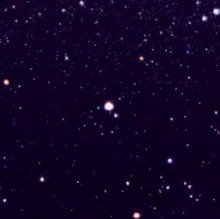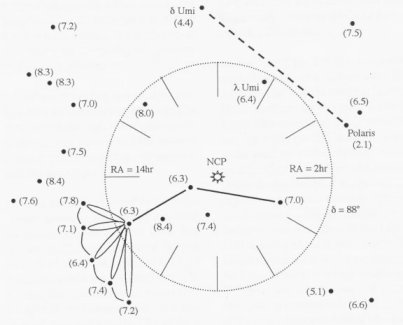
See the full-resolution image and more on polar stars in the Polar Project.
 |
Polaris (the jewel in a small semicircle
of faint telescopic stars called the "Engagement Ring") is centered
in a six-degree-wide field of view that shows a variety of other
"polar stars." HR 4686 is just to the right of the top center
edge. Lamdba Ursae Minoris is the
reddish star up and to the right of Polaris, while Yildun (Delta UMi)
is the brighter of the two stars at the upper right corner.
Roughly between Lambda and Polaris lies the North Celestial Pole,
around which they all seem to revolve.
See the full-resolution image and more on polar stars in the Polar Project. |
 |
HR 4686 is the bend in the stem of the English Rose, a
"constellation" fully visible only through the telescope that was
invented by Robert Hooke and presented in his "Discourse on
Earthquakes." While the other stars are not visible in the above
photo, the charming Rose can be seen down and just to the right of
Polaris in the deep image of Ursa Minor. Can you find it? Information and drawing from Martin Beech, "In Search of the English Rose, Robert Hooke's Lost Constellation," in the Journal of the Royal Astronomical Society of Canada, October 2004, p. 183. |